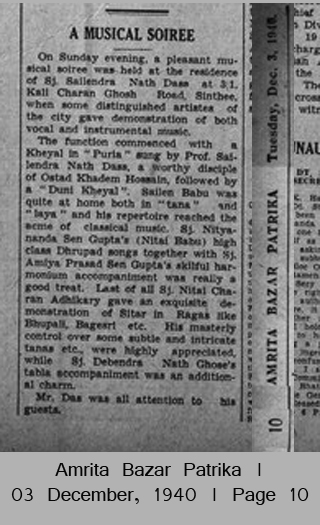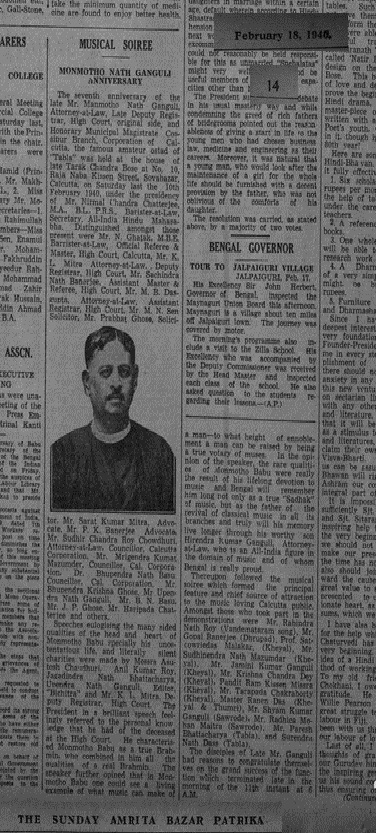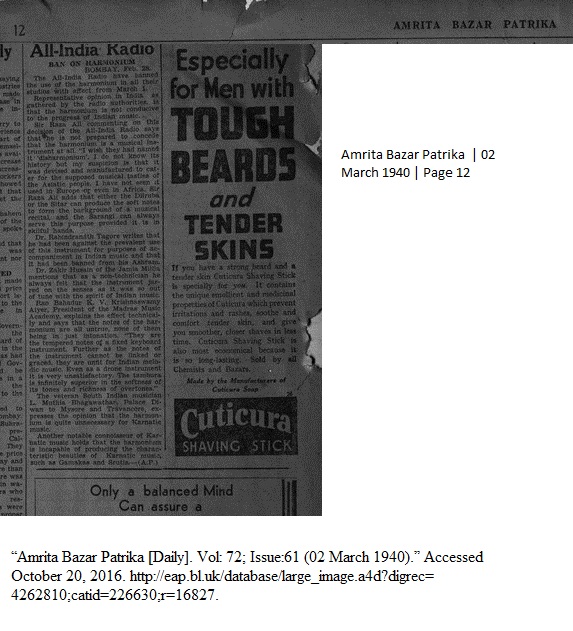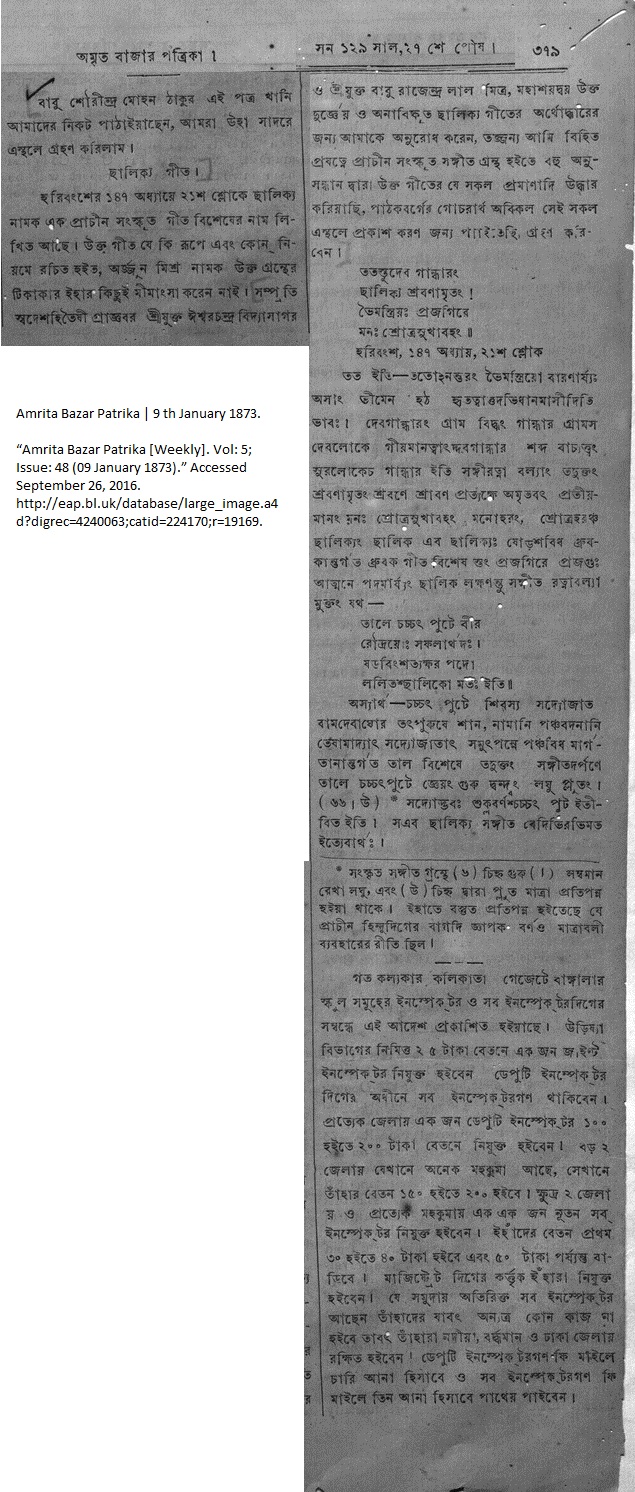AMRITA BAZAR PATRIKA | Wednesday, December 4, 1940 |
Page 10
AMRITA BAZAR PATRIKA |
Wednesday, December 4, 1940 | Page 10
NEW BROADCASTING HOUSE AT CALCUTTA
[By R. L. SURI, Deputy Installation Engineer, All – India Radio]
I wonder if listeners in Bengal and elsewhere have recently observed an improvement in the quality of programmes from the Calcutta Station All- India Radio. Calcutta’s Broadcasting House, which is been officially opened by H. E. the Governor of Bengal on December 3rd now has six new air-conditioned Studios with modern acoustic treatment and new technical equipment; The modifications have been carried out by The Installation Department of All-India Radio and have taken nine months to complete.
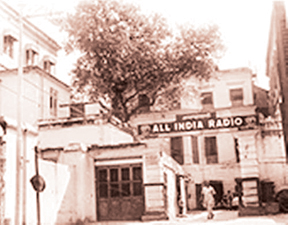
To describe these studios, let me for a moment transports you in imagination to the building at NO 1, Garstin Place. It is the same building which has previously been occupied but with the difference that the ground floor has also been taken over due to the increased accommodation required for more Studios and offices. We enter the premises and pass into the Reception Hall through the entrance door right under the porch with the ‘A. I. R.’ monogram moulded on it. The Control Room is on the left containing all the necessary technical equipment for controlling the Studios and programmes. We are now facing a large double swing door which opens into the corridor with Studio No 1. (To- Drama) on the left and Studio No 2 (for Indian Music) on the right. The swing door opposite opens into a lounge with Studio No 3 (For Talks) on the right and Studio No. 4 (For Dramatic Control) on the left. The third swing door opposite takes us into a passage and we face the waiting room, with the rehearsal rooms on its right and left. Studio No.5 (For European Music).Studio No. 6 (Second Dramatic Control) and Sound effects room are situated on the first floor. The offices are located partly on the first floor and partly on the second floor.
Why have we so Studios? Firstly because experience has proved the necessity of using different Studios with widely different acoustic conditions for various types of programmes in order to achieve the best possible result. For example, a small but comfortable Studio with little reverberation is just what is desired for Talks while we need a much larger capacity to accommodate two score musicians for an orchestral item. Certainly it will be appreciated as explained latter that for plays more than one Studio has to be engaged. In addition there are at times to progrrammes in broadcast simultaneously involving the use of at least two Studios. Another reason is that some of the programs have to be rehearsed several times, which keep the studios occupied for most of the time.
SOUND INSULATION
It will be appreciated that any extraneous noises developed outside the Studios, if allowed to enter the Studio affect the sensitive microphone and tend to interfere with the programme originating from it. This is more true of programmes of the nature of solos, news and talks, for this reason a minimum number of entrances is aimed at. All openings likely to affect leakage of sound are blocked or treated so as to provide sufficient insulation. Each of the Studios has a single entrance only which is a specially designed sound proof door about 5 inches thick. Extraneous noises, which were previously a source of great trouble at the Calcutta Station, have now been completely eliminated.
ACOUSTIC TREATMENT
After attending to the sound insulation work we commence with the preparation of the walls to take on the acoustic treatment. But someone asks, why have an acoustic treatment in the studios? Can’t we do without it? Let us go into a large and empty room and allow someone to speak at one end and while we listen at the other end. When he speaks one word at a time we probably can make out what he says about but we do notice that the sound of that word persists for some appreciable length of time owing to reflection and re-reflection from hard surface till it entirely dies away. But we can’t make out what the speaker says if he utters a few words following one another, as he would do in his ordinary course of speech. What is the reason? Obviously it is due to the overlap of one sound on other. The reflection of the first sound and the direct sound of the second have reached the ear simultaneously and have formed a jumble of words so that our ear is unable to interpret them .The root cause of this trouble is the persistence of the sound in the room. An engineer calls it ‘Reverberation’ and the time taken by any sound to die away to one millionth of its original strength is termed the ‘Time of Reverberation’ of that room. This varies at different frequencies. The object of acoustic treatment is to use a certain quality and quantity of an absorbing material so as to absorb the sound and thereby reduce the reverberation period to an optimum value. This depends on the size of the room or studio and the purpose to which it is to be put—music or speech. Methods of acoustic treatment are varied in nature although all aim at achieving the best results. In order to investigate this problem various experiments were carried out in an experimental studio at Delhi and the present method of acoustical treatment employing “building board” was evolved which at the same time gives the room a satisfactory appearance. Every one of the studios is tastefully decorated by means of groove cut designed in the building board. The decoration scheme is different in every Studio which lends individuality and a very modern appearance. All Studios have false ceilings which are also acoustically treated. Three are zig-zag in shape so as to allow uniform diffusion of sound in the Studio, as well as to avoid inter-reflection between the floor and the ceiling. These also greatly enhance the internal appearance.
AIR CONDITIONING
All the Studios, being hermetically sealed require forced air circulation and ventilation. The new Calcutta Studios also have the advantage of air-conditioning. Each Studio according to size contains one or two ‘air-conditioners’ (or cooling units) comparing cooling cools, a fan and a thermostat. The refrigerant (methyl chloride) is drawn in and returned to the plant. Room in pipes: The plant room contains a compressor with driving motor, condenser shut off valves for liquid and gas lines, the main switch board for starting and stopping the compressor motor and air-conditioning units in all the studios. Fresh air is let into the air-conditioners through special ducts to avoid transmission of outside noises. The air exhausted out through special ducts let into the walls. Both outlets and inlets with absorbing material for suppression of noise. The air is maintained automatically as described temperature by means of thermostats incorporated in each of the air conditioners in the Studios.
LIGHTING SYSTEM
The electric installation of the whole building has been renewed. The lighting scheme in all Studios except one is indirect by means of bowl sittings. The one exception is the Indian Music Studio which has tubular or architectural fittings fixed on the ceiling. The Studio corridor and lounge also have the same types of fittings fixed on to the ceilings.
SPECIAL TECHNICAL FEATURE
Let me now show you round the Control Room. The speech control equipment installed in it is assembled in two racks. Several modifications have been carried out in equipment to obtain the maximum operation facilities and to allow easy and prompt checking in the event of break down.
The present arrangement allows transmission of two programmes (one on the abort wave and second on the medium wave) and two auditions to be carried out simultaneously. Two separate ‘mixing’ or Control positions are provided—one for short wave and one for the medium wave. Sound picked up by microphone in the Studio is amplified by about a million times in the Control, Room before they are sent to Transmitters at Cossipur by underground cable.
Four 25 watt bridging amplifier are mounted in the third rack and are employed for feeding the loud speaker circuits for monitoring, audition and ‘talk back’ purposes. All the Studios, Control Room and six offices have been equipped with loud speakers to enable the staff to listen to any of the four channels. The loud-speakers in the Studios are for ‘talk back’ purposes. Any unengaged Studio, however, can be used as a listening room and audition can be listened to.
DRAMATIC CONTROL PANEL
One of the special technical features provided for this Station is Dramatic Control Panel .A Dramatic Control Panel comprises six channels or faders connected thus: one to the announcer’s microphone for the producers of the drama, one to each one to each of the two gramo-reproducers installed on one side of the table, one of the sound effect room and two of the remaining to two Studios—ONE being adjacent to the Dramatic Control Studio and the second on the other floor. For each of the programme source outside this room and associated with its ‘fader’ is a key which enables the producer to flick a cue light installed in that particular Studio for the ‘alert’ or ‘stop’ signal. There is a similar key in the Studio to flick a light in the D.C. Panel room. Now as to its utility. It may first be mentioned that there are certain types of feature programmes which need the use of more than one Studios. Previously such programmes constituting music, song [Solos as well Chorus ], Conversations and sound effects were all performed and managed in one single medium-sized room. In certain plays broadcast on Fridayas from this Station. I have seen as many as fifty people featured in it. In addition to the congestion involved which affected adversity the performance of some artists. It retained a tremendous efforts and strain on the part of the producer to convey the desired atmosphere and effect that he had visualised. In order to overcome these difficulties and to co-ordinate various parts of an elaborate programme such as this D.C. Panel is brought into operation. The artist can follow the continuity of the programme by means of head-phones provided in the Studios. In some of the Studios the artists can listen to the announcement made by the producer directly for the speakers provided in the Studios.
OTHER FACILITIES
In addition to the above the producer can listen to the programme re-produced from the loud-speakers in that same room which is automatically switched off when he fades up his own microphones for making announcement.
Facilities are also provided which enable the producer to ‘talk-back’ to the artists through the Studio speakers during auditions or rehearsals. The gramo-producer sets provided are used for recorded effects during plays and for regular programmes. Sporting or other special announcement and market reports etc, are also broadcast from this room. Two such Dramatic Control positions, one each in Studio No. 4 and 6 have been provided.
It may be of interest to mention that about five miles of cable was used for loud-speakers, headphones signaling and clocks circuits and 1000 yards of cable for the microphones.
DISC RECORDING EQUIPMENT
There are many items of interest which happen at odd hours of the night or at inconvenient time of the day and cannot be relayed immediately, either because the station is closed down or because the majority of listeners are not at home to tune in. In such cases the recording equipment is put into service. The equipment is similar to that used by the gramophone companies. There are, however, two main points of difference-Firstly that the recording head cut grooves on a cellulose-coated metal disc instead of a wax disc. Secondly this method permits immediate play-back, while the wax disc has to undergo several processes before a record is ready for play-back. We have two similar types of recording machines so as to record simultaneously to obtain a duplicate copy or to make continuous recordings. These records are not permanent but can be played over a dozen times without appreciably affecting the quality.
The equipment is mobile and has frequently to be carried to the desired spot for making records of talks or effects etc. Dr Rabindra Nath Tagore’s talks for example, are usually recorded at his residence and broadcast at the appointed time. There are in fact numerous everyday uses to which the equipment is put to.
SIGNALLING SYSTEM
An illuminated signaling system is used between the Control Room and the Studios for instantaneous change-overs to one Studio to another.
There are numerous other problems which need careful thought while designing a broadcasting Studio. Excellent results achieved in respect of sound insulation, acoustics and technical facilities justifies the time and energy expanded in this direction. But this is not all. Modern steel furniture and carpets enhance the appearance of the Studios, as will be seen from the illustration. In future the listeners will have the advantage of both the improved quality of reception from these new Studios as well as the improvement in programme production which will be possible with the additional facilities provided.
Source:
Identified by Rajeswary Ganguly Banerjee, Research Fellow
Data processed at SAP-DRS Lab, Department of Instrumental Music, Rabindra Bharati University.





